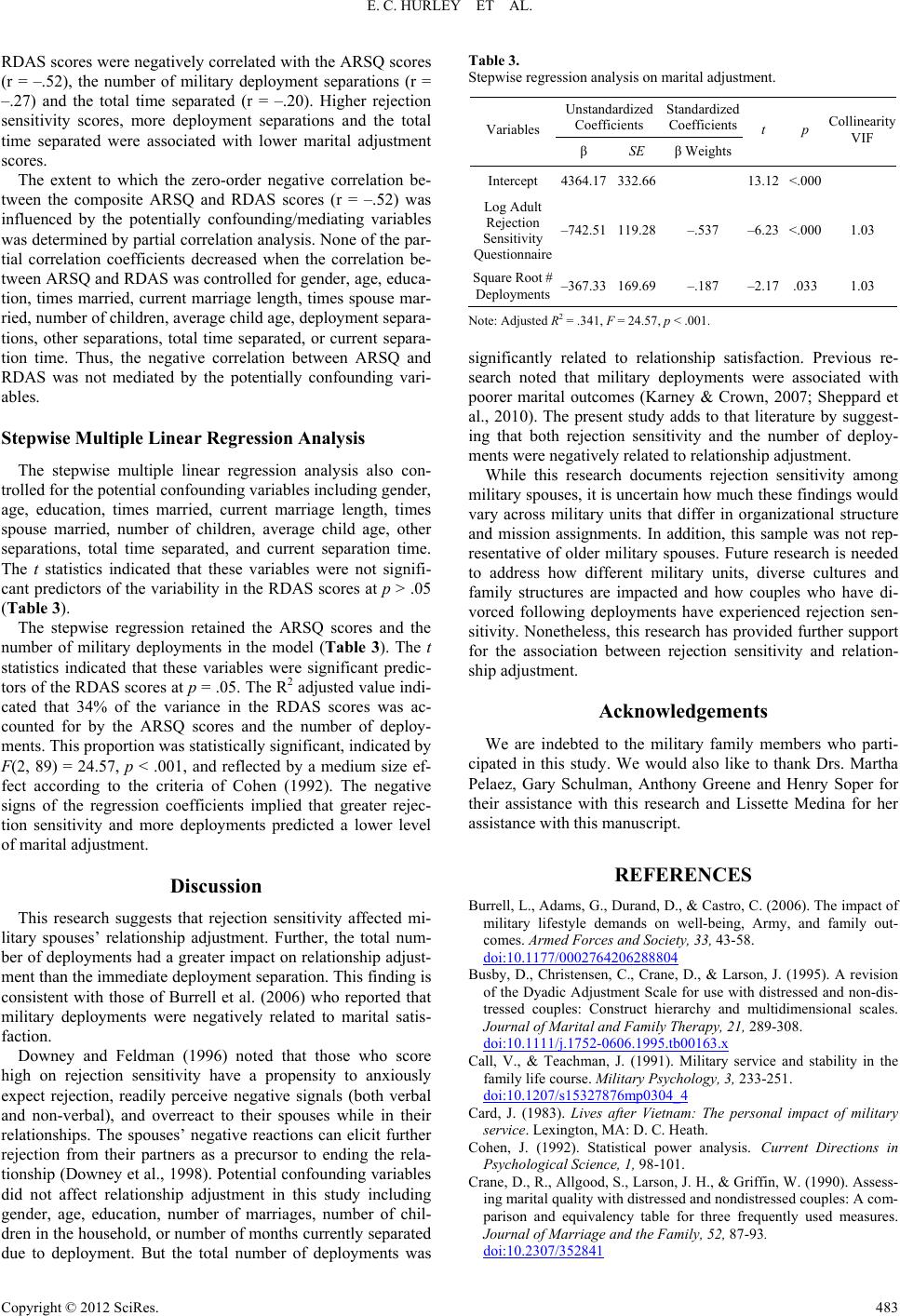
E. C. HURLEY ET AL.
RDAS scores were negatively correlated with the ARSQ scores
(r = –.52), the number of military deployment separations (r =
–.27) and the total time separated (r = –.20). Higher rejection
sensitivity scores, more deployment separations and the total
time separated were associated with lower marital adjustment
scores.
The extent to which the zero-order negative correlation be-
tween the composite ARSQ and RDAS scores (r = –.52) was
influenced by the potentially confounding/mediating variables
was determined by partial correlation analysis. None of the par-
tial correlation coefficients decreased when the correlation be-
tween ARSQ and RDAS was controlled for gender, age, educa-
tion, times married, current marriage length, times spouse mar-
ried, number of children, average child age, deployment separa-
tions, other separations, total time separated, or current separa-
tion time. Thus, the negative correlation between ARSQ and
RDAS was not mediated by the potentially confounding vari-
ables.
Stepwise Multiple Linear Regression Analysis
The stepwise multiple linear regression analysis also con-
trolled for the potential confounding variables including gender,
age, education, times married, current marriage length, times
spouse married, number of children, average child age, other
separations, total time separated, and current separation time.
The t statistics indicated that these variables were not signifi-
cant predictors of the variability in the RDAS scores at p > .05
(Table 3).
The stepwise regression retained the ARSQ scores and the
number of military deployments in the model (Table 3). The t
statistics indicated that these variables were significant predic-
tors of the RDAS scores at p = .05. The R2 adjusted value indi-
cated that 34% of the variance in the RDAS scores was ac-
counted for by the ARSQ scores and the number of deploy-
ments. This proportion was statistically significant, indicated by
F(2, 89) = 24.57, p < .001, and reflected by a medium size ef-
fect according to the criteria of Cohen (1992). The negative
signs of the regression coefficients implied that greater rejec-
tion sensitivity and more deployments predicted a lower level
of marital adjustment.
Discussion
This research suggests that rejection sensitivity affected mi-
litary spouses’ relationship adjustment. Further, the total num-
ber of deployments had a greater impact on relationship adjust-
ment than the immediate deployment separation. This finding is
consistent with those of Burrell et al. (2006) who reported that
military deployments were negatively related to marital satis-
faction.
Downey and Feldman (1996) noted that those who score
high on rejection sensitivity have a propensity to anxiously
expect rejection, readily perceive negative signals (both verbal
and non-verbal), and overreact to their spouses while in their
relationships. The spouses’ negative reactions can elicit further
rejection from their partners as a precursor to ending the rela-
tionship (Downey et al., 1998). Potential confounding variables
did not affect relationship adjustment in this study including
gender, age, education, number of marriages, number of chil-
dren in the household, or number of months currently separated
due to deployment. But the total number of deployments was
Table 3.
Stepwise regression analysis on marital adjustment.
Unstandardized
Coefficients
Standardized
Coefficients
Variables
β SE β Weights
t p
Collinearity
VIF
Intercept 4364.17332.66 13.12 <.000
Log Adult
Rejection
Sensitivity
Questionnaire
–742.51119.28–.537 –6.23 <.000 1.03
Square Root #
Deployments–367.33169.69–.187 –2.17 .0331.03
Note: Adjusted R2 = .341, F = 24.57, p < .001.
significantly related to relationship satisfaction. Previous re-
search noted that military deployments were associated with
poorer marital outcomes (Karney & Crown, 2007; Sheppard et
al., 2010). The present study adds to that literature by suggest-
ing that both rejection sensitivity and the number of deploy-
ments were negatively related to relationship adjustment.
While this research documents rejection sensitivity among
military spouses, it is uncertain how much these findings would
vary across military units that differ in organizational structure
and mission assignments. In addition, this sample was not rep-
resentative of older military spouses. Future research is needed
to address how different military units, diverse cultures and
family structures are impacted and how couples who have di-
vorced following deployments have experienced rejection sen-
sitivity. Nonetheless, this research has provided further support
for the association between rejection sensitivity and relation-
ship adjustment.
Acknowledgements
We are indebted to the military family members who parti-
cipated in this study. We would also like to thank Drs. Martha
Pelaez, Gary Schulman, Anthony Greene and Henry Soper for
their assistance with this research and Lissette Medina for her
assistance with this manuscript.
REFERENCES
Burrell, L., Adams, G., Durand, D., & Castro, C. (2006). The impact of
military lifestyle demands on well-being, Army, and family out-
comes. Armed Forces and Society, 33, 43-58.
doi:10.1177/0002764206288804
Busby, D., Christensen, C., Crane, D., & Larson, J. (1995). A revision
of the Dyadic Adjustment Scale for use with distressed and non-dis-
tressed couples: Construct hierarchy and multidimensional scales.
Journal of Marital and Family Therapy, 21, 289-308.
doi:10.1111/j.1752-0606.1995.tb00163.x
Call, V., & Teachman, J. (1991). Military service and stability in the
family life course. Military Psychology, 3, 233-251.
doi:10.1207/s15327876mp0304_4
Card, J. (1983). Lives after Vietnam: The personal impact of military
service. Lexington, MA: D. C. Heath.
Cohen, J. (1992). Statistical power analysis. Current Directions in
Psychological Science, 1, 98-101.
Crane, D., R., Allgood, S., Larson, J. H., & Griffin, W. (1990). Assess-
ing marital quality with distressed and nondistressed couples: A com-
parison and equivalency table for three frequently used measures.
Journal of Marriage and the F amily, 52, 87-93.
doi:10.2307/352841
Copyright © 2012 SciRes. 483